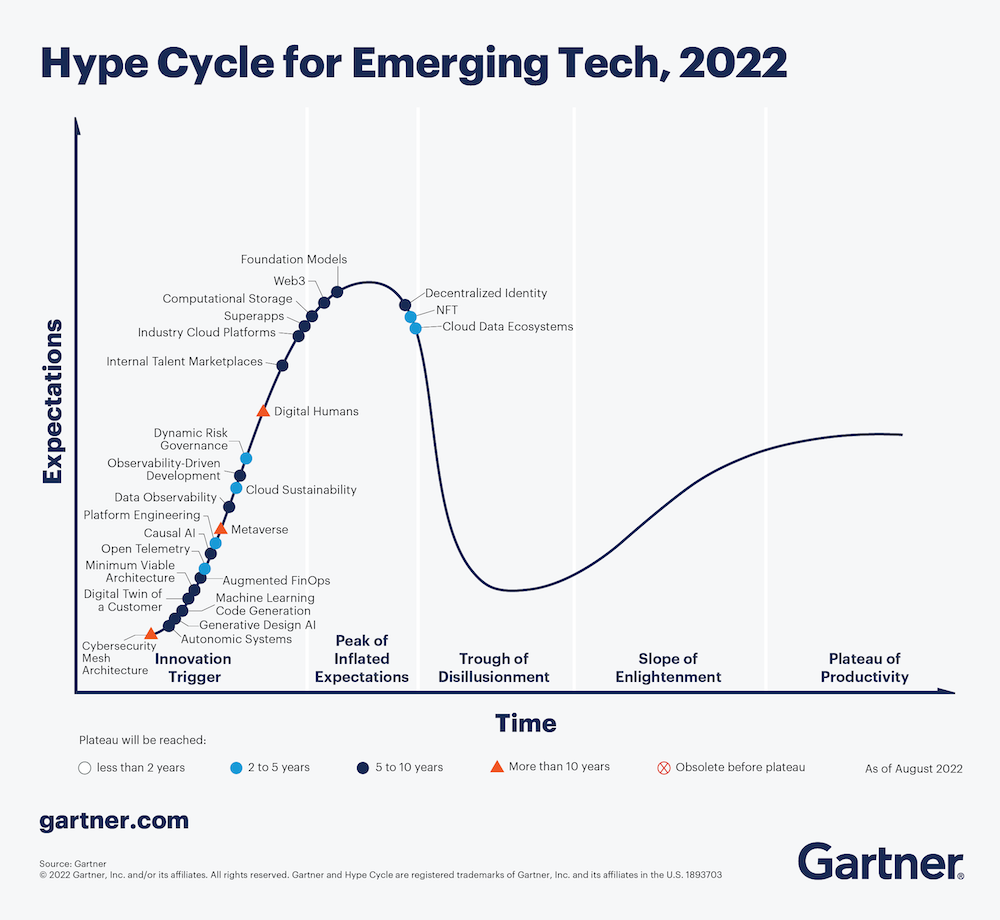Is the Metaverse Dead?

With generative AI grabbing the headline and massive investment, has the Metaverse become yet another technology that failed to find an audience?
Two years ago, the Metaverse was heralded as a new age for virtual interaction, collaboration, and entertainment. For many, the Metaverse has withered on the vine as investment and interest have switched to generative AI. However, is the Metaverse really dead? Or has this technology just moved out of the spotlight for now?
For many, the Metaverse as a technology has failed so far to live up to the hype. Despite billions invested, VR generally has not set the business world alight. Indeed, Microsoft closed the development of Altspace VR, which it bought in 2017. Today, the Seattle giant is firmly betting on generative VR with massive investment in OpenAI. So, where does this leave the Metaverse? Just for gamers? Could Apple’s mixed reality Vision Pro deliver the kind of immersive experiences the Metaverse had promised, at least to those that can afford it?
Gartner points to an extended timeline for the Metaverse with its hype cycle prediction placing the Metaverse that Meta envisioned being several years away from practical applications. As with many technologies that took time to evolve and develop, it may be too early for the Metaverse to make a real impact – but an impact it will make as the hardware and software that supports it also evolves and develops. McKinsey report that in the first half of 2022 alone, over $120 billion was invested in Metaverse technologies.

“The cryptocurrency and NFT markets really overwhelmed the industry early on, magnifying the hype, failing to deliver, and very much muddying the waters about what the Metaverse is, what it could be, and its real potential to change the world,” Robert Rice, CEO of Transmira commented to Silicon UK.

“With the crypto winter and disasters like FTX, combined with the abrupt entry of AI and GPT into the industry, much of the media attention and news pivoted to the next shiny thing. This makes it seem like the Metaverse has declined or stagnated, when in reality there is a lot going on and a good deal of innovation. The fundamentals are solid, and as we see another convergence of technologies where Metaverse tech pulls in AI with some amazing applications, the media shift will happen again. We are still in the early days here, and anyone claiming that the Metaverse is dead or not going anywhere, really don’t have a good sense of the market or an understanding of the technology.”
As a group of technologies, the Metaverse, from a business perspective, has some way to go yet to form solid and fundable use cases. However, as the technology improves, adoption should increase as enterprises see the value of investing.
“The metaverse by nature is designed to allow people to be more creative and to have the option to do this collectively,” says Emma Chiu, Global Director of Wunderman Thompson Intelligence. “The rise of generative AI appears to be the new exciting, consumer-ready tech to focus on. However, generative AI and the metaverse could be stronger together. Integrating generative AI capabilities into the metaverse could allow anyone to be able to create their own worlds, avatars, etc. This could see a new class of creatives.”

Building the virtual
A recent survey from Protiviti-Oxford suggests investment in the Metaverse has not just been in the gaming space: “84% of North American executives categorise the Metaverse’s potential global impact as ‘significant’ or ‘somewhat significant,’ while that number dips to 54% in Europe and 53% in Asia-Pacific. An impressive 85% of North American executives say it will be important to their future business success. That percentage drops significantly in Europe (46%) and Asia-Pacific (57%).”
The survey also asked respondents what would stop them from investing in the Metaverse: “When executives consider what factors could put the brakes on their Metaverse plans, cost (44%) is the biggest roadblock. Perhaps, not surprisingly, privacy and security (42%) were next, followed by interoperability (34%), technology infrastructure (30%), user experience and enthusiasm (25%), regulations and agreement on standards (15%), and miniaturisation of devices (10%). Interestingly, while cost is the number one concern in Europe and North America, it was number five in Asia-Pacific, ranked behind technology infrastructure, privacy, security, interoperability, user experience and enthusiasm.”
Jing Sun, CIO, COO and Co-founder, LoTeX, commented to Silicon UK: “I wouldn’t say that the Metaverse is not dead at all. I’d say it’s more accurate to point out that it’s in its early stages of evolution. The concept is expansive and evolving with the advancement in related technologies like VR, AR, AI, and blockchain. The timeline may be longer than initial hype suggested, but the industry’s direction points toward a future in which the Metaverse plays a significant role.”

In addition, Laura Henchoz, UK&I Client Technology Markets Leader at EY, says: “There are many examples where businesses have started building virtual environments, many of which happened during COVID-19. For example, estate agencies had no choice but to use virtual reality to conduct viewings online. The financial industry has also been considered an early mover – banks have been using the technology for training purposes, while wealth and asset managers are using the Metaverse to create new touchpoints with high-earning digitally native customers.”

Henchoz continued: “Even those companies which aren’t actively building Metaverse environments are preparing for its impact. For example, 40% are recruiting specialist talent, while a further 39% are establishing partnerships with suppliers and other parties in the ecosystem. And 38% have assigned a senior executive to lead their Metaverse-related efforts or set up pilot teams and 37% have launched strategic planning.”
A Metaverse renaissance
Forrester looked at the business take-up of VR last year, revealing that only 8% of respondents used the technology in a business setting. Microsoft, for example, launched 3D avatars for Teams meetings with little other development in the VR space, gaining much of their time for investment. Once again, generative AI rears its head here. Perhaps linking Microsoft’s office applications with Quest Pro headsets will open the door for more business use of the Metaverse.
All eyes are on Apple next year, and how their Vision Pro will be marketed, and the technology’s uptake. It’s not likely Apple will focus on the working environment, at least initially, but the potential could be massive and become the killer app the Metaverse needs to move the technology into mainstream business adoption.
Transmira’s CEO, Robert Rice, commented: “Businesses need to understand the Metaverse and the convergence of these key technologies and then develop a corporate strategy that extracts real value and utility while advancing corporate goals. It isn’t enough to have a token “presence” on the Metaverse or consider it little more than a marketing tool or a fad. There are real use cases and capabilities that Metaverse technology can offer, and early adopters that have a real strategy will have a razor-sharp competitive edge and massive market advantage.”
As LoTeX’s Jing Sun pointed out, we must be patient and wait for these technologies to mature: “As with all transformational technology, it’s important to view Metaverse from all angles. While it promises innovation, entertainment and social connection opportunities, it also raises several privacy, security, digital and societal impact concerns. These challenges must be addressed along with the development of the Metaverse to realise its potential responsibly and inclusively.”
And Laura Henchoz, UK&I Client Technology Markets Leader at EY, outlined what she thinks are the keys to the Metaverse kingdom: “According to our survey respondents, the most important attributes needed to increase adoption of Metaverse applications were security (39%), trust (34%), inclusiveness (31%) and accessibility (30%). In other words, to be successful in the Metaverse, organisations must build environments that offer trusted customer experiences. This means that customers must feel safe circulating and transacting in virtual worlds, whatever their circumstances, and they must find them easy to navigate.”
Perhaps many in the industry have been quick to sound the death knell of the Metaverse. VR remains a niche technology even after decades of development. But a perfect storm could be approaching.
Wunderman Thompson Intelligence’s Emma Chiu thinks we need to give the technology time: “When virtual reality first came about, people were trying to tell stories through the lens of what they already know, such as short films or games. However, over time it has become a medium which is changing the way we can tell stories, where it doesn’t have to be so linear, one-dimensional or passive. It has quickly become an interactive, multi-dimensional and creative outlet for people to convey complex ideas, emotions and even put people in the shoes of others. The metaverse needs to have time for people to experiment and evolve it. It needs time to mature and find its true potential.”
The cumbersome hardware to enable fully immersive environments is being refined with all eyes again turning to Apple. But other technologies are also needed: Processing power is a good example. Oddly, the obsession with generative AI has powered the massive expansion of companies like Nvidia. Coupled with fast connectivity, these elements all lend themselves to the continued development of the Metaverse. All we need is someone to connect the dots.
![]()
Dan Smalley, Program Manager for Siemens Xcelerator UK&I.

Daniel Smalley is Business Manager for Factory Automation and Digitalisation at Siemens UK and Ireland and is Program Manager for Siemens Xcelerator – an open digital business platform that encourages customers to accelerate their digital transformation easier, faster and at scale.
There was a lot of hype surrounding the Metaverse in the past. Do you think the initial enthusiasm has waned, or is it still a prominent concept in the tech industry?
“We’ve been manufacturing VR and digital twins for over ten years. And for this reason, we recognise that rather than being a new concept, the industrial Metaverse represents the next evolutionary step in the transition to an interconnected, digital world.
“Despite often being perceived as more ideological than practical, the Metaverse – in industrial form – is already starting to transform how we design, manufacture, and interact with each other across different industries.”
What significant factors have contributed to any perceived decline or stagnation of the Metaverse concept, if any?
“Tackling misconceptions will be vital in improving levels of adoption. The consumer-facing aspects of the Metaverse were unveiled with much fanfare, which mainly focused on how social interactions could take place in a virtual world. In some ways this has not been helpful for other applications of the Metaverse. And, many argue, we actually need to move past thinking of the Metaverse as a consumer-only concept. In the industrial world it could revolutionise processes helping to many of the way things are designed, built and produced more effective, quicker and less wasteful.”
Are there any successful implementations or real-world applications of the Metaverse that demonstrate its potential viability?
“We have been using digital twin technology – where digital modelling is combined with monitoring, analysis and simulation – for almost a decade across a growing range of applications. And these experiences have fed into the first executions of an industrial metaverse.
“For example, earlier this year, Siemens announced work with battery manufacturer Freyr to develop a digital twin of its next generation of Gigafactories in Norway. Integrating operational data with 3D models of the site allows us to simulate and optimise manufacturing processes in advance, helping Freyr to work faster, more sustainably and at a grander scale.
What challenges or barriers has the Metaverse faced in gaining widespread adoption, and how have these impacted its development?
“Many tech companies are working on building the Metaverse – but the scale of the task dictates that no one company will be able to achieve it alone. Widespread adoption will require scalable and consistent collaboration across businesses and industries. Importantly this should also include both hardware and software – both the real and digital worlds.
“This will also be an essential step in ensuring the metaverse is delivered in the most sustainable way possible. But this will be incredibly hard without a set of standards that dictate how we collaborate. Introducing this would encourage co-operation between leading players in the space and act as a cornerstone for future innovation.”
Has the rise of generative AI moved business strategies away from the Metaverse?
“While AI is perhaps stealing some of the media limelight that the Metaverse previously had, we don’t see the two as mutually exclusive – they are inherently linked.
“Generative AI plays a key part in the generation of industrial simulations, and several companies have already integrated this technology into their design tools. Harnessing the capabilities of both AI and the metaverse will be imperative in building for the future.”
How does the current state of technology, such as augmented reality (AR) and virtual reality (VR) advancements, influence the potential of the Metaverse?
“Accessing the technology required to interact with the metaverse – such as AR and VR – has historically been perceived as a barrier because of upfront cost. From an industrial perspective, these barriers are starting to come down as more firms realise the long-term cost savings that can be made through digitalisation, offsetting the initial investment. Equally there’s growth in “as-a-Service” modelling that is helping encourage adoption – both for large scale deployments and among smaller manufacturers who couldn’t previously justify the investment.”
Are there any lessons to be learned from previous virtual world attempts that could inform the future development of the Metaverse?
“People tend to have unrealistic expectations about the speed of technology adoption. The Metaverse will not be built overnight. Leveraging the full breadth of insight and knowledge within the industrial ecosystem will take time, effort and collaboration across all industries, technologies and governments. Achieving this requires patience and will involve recognising both our strengths and weaknesses and honest communication about how they can be addressed.”